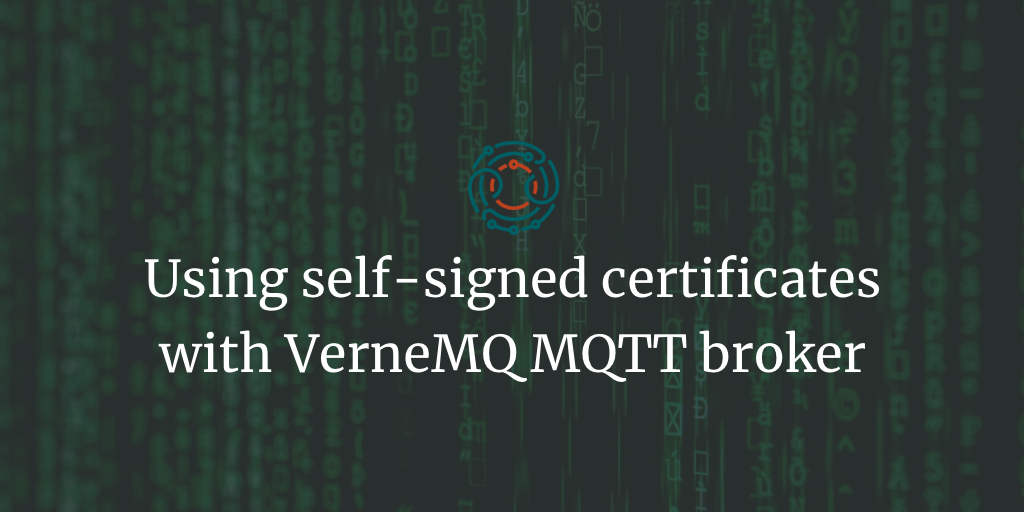Using self-signed certificates with VerneMQ MQTT broker

MQTT is a common protocol for IoT (Internet of Things) devices communication. It's lightweight and energy efficient, but lacks security in general. In 21 century, you must> use encryption in production. In today quick note we will show how to use VerneMQ MQTT broker with self-signed certificates for TLS encryption.
Why self-signed certificates?
When we talk about HTTPS, it's nobrain decision to use Let's Encrypt for websites. If you know why you should not use Let's Encrypt you donэt need to read this article :) It's possible to use LE for MQTT certificates, but there is a problem.
If you are using embedded devices with small computational capabilities, you will need a way to check server identities. In case of LE, their Certificate Authority certificates are only valid for 3 years. That means that you will need to update these CAs on devices every 3 years (or every 1 year). This process is not trivial and can be a security hole in the devices.
If you are making a prototype or don't want to mess with certificates update on devices, it's better to use self-signed certificates for this. You can make certificate valid for 3650 days (10 years) and forgot about it. This will encrypt the connection and make it secure. But to verify the identity of the certificate you will need to upload CA or certificate itself to the device. This is much easier, than making revocation and rotation code.
Step-by-step instruction
1. Generate public and private RSA keypair for CA:
openssl genrsa -out vernemq_ca.key 20482. Create CA certificate:
openssl req -new -x509 -days 3650 -key vernemq_ca.key -out vernemq_ca.crt3. Create VerneMQ keypair:
openssl genrsa -out vernemq.key 20484. Create certificate request from CA:
openssl req -new -out vernemq.csr -key vernemq.key5. Verify and sign the certificate request: create cert.cnf, edit values (names, DNS and IPs) and run command:
[ req ]
default_bits = 2048
default_md = sha512
default_keyfile = vernemq.key
prompt = no
encrypt_key = no
distinguished_name = req_distinguished_name
[ req_distinguished_name ]
countryName = RU
stateOrProvinceName = Moscow
localityName = Moscow
organizationName = Ivy Knob
commonName = ivyknob.com
[ req_ext ]
subjectAltName = @alt_names
[ alt_names ]
DNS.1 = localhost
DNS.2 = mqtt.ivyknob.com
IP.1 = 127.0.0.1
IP.2 = 192.168.0.10
IP.2 = 1.1.1.1openssl x509 -req -in vernemq.csr -CA vernemq_ca.crt -CAkey vernemq_ca.key -CAcreateserial -extensions req_ext -extfile cert.cnf -out vernemq.crt -days 3650openssl x509 -text -noout -in vernemq.crt -certopt no_subject,no_header,no_version,no_serial,no_signame,no_validity,no_issuer,no_pubkey,no_sigdump,no_aux6. Copy vernemq.crt, vernemq.key, vernemq_ca.crt to the folder with certificates:
7. Add listener in the vernemq.conf file:
listener.ssl.cafile = /etc/vernemq/vernemq_ca.crt
listener.ssl.certfile = /etc/vernemq/vernemq.crt
listener.ssl.keyfile = /etc/vernemq/vernemq.key
listener.ssl.default = 0.0.0.0:88838. In the client use vernemq_ca.crt or vernemq.crt file to verify identity of the MQTT broker.
To test broker to work over ssl use these mosqutto CLI commands:
Subscribe to the topic:
mosquitto_sub -h localhost -p 8883 --cafile ./vernemq_ca.crt -t "test/test" -dmosquitto_pub -h localhost -p 8883 -t test/test -m "test" -d --cafile ./vernemq_ca.crt